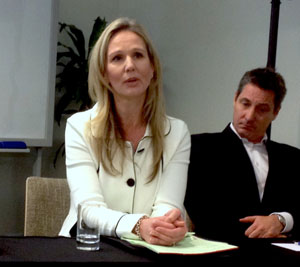SMBs are the NBN's sweet spot

With National Broadband Network (NBN) take-up rates among small and medium businesses approaching 90 per cent in some regional first-release sites, NBN Co is counting SMBs amongst its biggest fans, with those to receive services from those businesses likely set to gain the most.

Jane Burns
(Credit: David Braue/ZDNet Australia)
The figure — relating to SMBs in the Willunga, South Australia first-release area — came from NBN general manager for external affairs Trent Williams, as he fronted an NBN education forum in Melbourne, organised as part of the company's ongoing charm offensive.
"Willunga has shown that a lot of small businesses are a very easy audience to get through the message about the NBN," said Williams, who is among the NBN Co staffers moving through rural and regional centres ahead of the fixed-wireless rollout, to talk up the network's possibilities. "They know this is going to be helping them, and they see it as a source of competitive advantage."
One person who needs no convincing is Dr Jane Burns, CEO of Melbourne-based adolescent support initiative the Young and Well Cooperative Research Centre, who sees pervasive NBN broadband as a way of extending traditional support mechanisms all the way into homes, where troubled young people in crises often retreat outside the reach of potentially life-saving support services.
As a mother to three children aged five or under — including an older son dealing with Down syndrome and autism — Burns knows all too well the costs of inaccessibility to medical care. Experiences such as a $400 doctor's visit, after which she was unceremoniously told to give her son Parachoc to deal with constipation, made clear for her the cost for regional residents having to travel for even rudimentary support.
This experience — as well as a desire to ensure her children can access support services by the time they reach their teenage years — encouraged her to accept a nomination as one of 21 government 'broadband champions', who work alongside NBN Co to spruik the social benefits of ubiquitous connectivity.
"The internet is a significantly huge way of connecting with young people," Burns explained, presaging the creation of NBN-enabled 'virtual clinics' and school-based wellness clinics, to enable regular interactions with health professionals.
"We know that 70 per cent of them don't actually go in to see a professional, see a GP or see a teacher at school [when they're having trouble coping]. Particularly in remote communities, where there are limited professionals, you've actually got to get professionals online. If someone is in crisis and needs to speak to someone really quickly, [NBN-based services] could give them 24x7 access to support."
In a commercial sense for the GPs, new forms of patient interaction offer opportunities to improve the service for existing customers and develop service offerings to attract new ones.
Yet, not everyone is as eager for the NBN as those in Willunga, Williams admitted after being asked about a rural Melbourne-area council that recently rejected a NBN Co application for a 40m broadcast tower due to its impact on local amenity.
Citing the "fantastic" take-up rate for fixed-wireless NBN services in outlying areas of NSW's Armidale as a sign that the "silent majority" supported the network, Williams said that the network itself tended to silence critics once they understood its benefits.
"People are very vocal when they're against something," Williams conceded. "Typically, it's the objectors that are most organised and most vocal. But the more we get out there and present the facts, people are saying 'hang on, I do support this'."